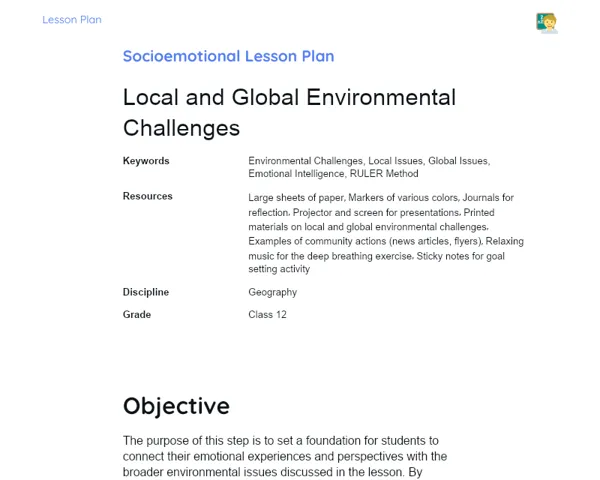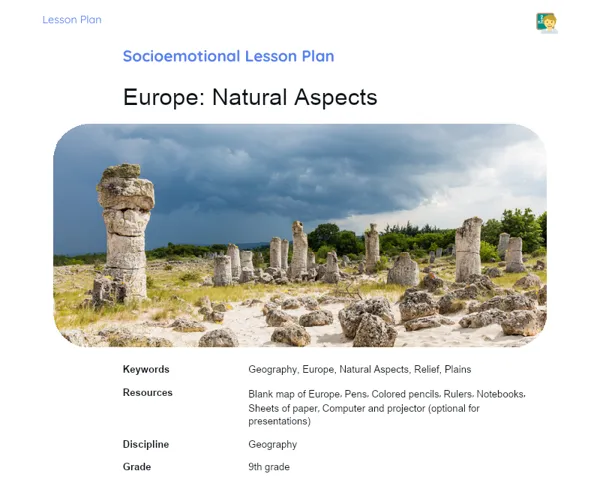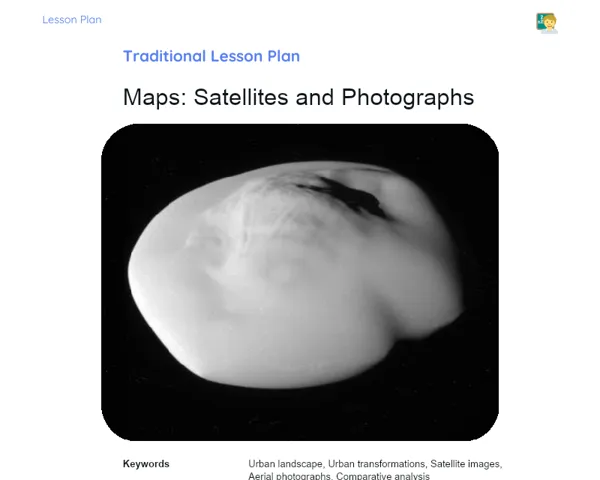Lesson Plan | Lesson Plan Tradisional | Different Places
| Keywords | Geography, Different Places, Home, School, Characteristics, Differences, Similarities, Observation, Analysis, Interaction |
| Resources | Whiteboard, Markers, Paper, Pencils, Erasers, Images of various places (home, school, park, etc.), Projector (optional), Poster board, Colored markers |
Objectives
Duration: (10 - 15 minutes)
This stage aims to introduce students to the topic, setting a strong foundation for comprehending the content that will be explored. By outlining the key objectives, students will understand what is expected of them by the end of the lesson, aiding their ability to absorb and retain the information shared.
Objectives Utama:
1. Identify and describe the unique characteristics of places that students visit, such as their homes and schools.
2. Compare and contrast the key differences and similarities between these locations.
3. Develop the skill to list relevant information regarding the discussed places.
Introduction
Duration: (10 - 15 minutes)
This stage serves to initiate students into the topic, ensuring a solid foundation for understanding the upcoming content. By defining the main objectives, students can anticipate what is expected by lesson's end, promoting their ability to absorb and remember the material presented.
Did you know?
Did you know that each place has its own 'personality'? For instance, the library is typically a quiet zone for reading and studying, whereas the playground is buzzing with joy and laughter. Just like us, each place has traits that make it special and memorable!
Contextualization
To kick off the lesson on 'Different Places', start by sharing that we all visit various locations in our daily lives. Ask students about the places they often frequent, such as their homes, schools, parks, or relatives' houses. Emphasize that every one of these places has its own unique features that make it special and significant to us. Provide relatable examples, like the classroom where they learn, the kitchen where they eat with family, or the playground where they have fun.
Concepts
Duration: (40 - 45 minutes)
This stage enhances students' understanding of the various places they encounter, emphasizing the specific characteristics of each location. By discussing and comparing home and school, students cultivate observation and analytical abilities, crucial for their geographical and social comprehension.
Relevant Topics
1. Characteristics of Home: Explain that home is where we live. Describe key areas in a house, including the living room, kitchen, bedrooms, and bathroom. Stress that each of these spaces plays a distinct role.
2. Characteristics of School: Explain that school is where we learn and have fun. Discuss various areas in the school, such as the classroom, playground, library, and cafeteria. Outline the function of each area.
3. Differences and Similarities: Compare home and school. Highlight similarities, such as both being safe havens where we spend significant time. Discuss differences, including the activities we engage in at each location and the individuals we interact with there.
To Reinforce Learning
1. What are three different areas you find in your home? Describe what activities take place in each.
2. What are three different areas you find in your school? Describe what you do in each of them.
3. List one similarity and one difference between your home and your school.
Feedback
Duration: (25 - 30 minutes)
This stage aims to review and solidify the knowledge gained by students, promoting reflection and discussion about the various places they frequent. This time allows students to articulate their opinions and insights, enriching the learning process through an interactive and meaningful exchange.
Diskusi Concepts
1. Discussion of the Questions: 2. What are three different areas you find in your home? Describe what activities take place in each. 3. Living room: A space where the family gathers to watch TV, chat, and unwind. 4. Kitchen: The heart of the home where meals are cooked and families share meals together. 5. Bedroom: A personal retreat for sleeping, playing, and storing belongings. 6. What are three different areas you find in your school? Describe what activities happen in each. 7. Classroom: The space where students attend lessons, learn, and participate in activities. 8. Playground: An outdoor area where students engage in play, exercise, and social interaction during breaks. 9. Library: A quiet place for reading, studying, and conducting research. 10. List one similarity and one difference between your home and your school. 11. Similarity: Both are safe environments where we spend quality time and learn new things. 12. Difference: At home, we engage in family activities, while at school, we focus on academic learning along with classmates and teachers.
Engaging Students
1. Questions and Reflections for Student Engagement: 2. What’s your favorite spot in your home? Why do you like it? 3. What’s your favorite place at school? Why is it special to you? 4. Do you think a 'classroom' can exist at home? What would it look like? 5. If you could change one thing about your school, what would it be? Why? 6. How do you feel in the different places you visit? Do you feel more at ease at home or at school? Why?
Conclusion
Duration: (10 - 15 minutes)
This stage is designed to summarize and consolidate the key points discussed during the lesson, reinforcing learning and ensuring that students depart with a comprehensive and practical understanding of the content. It also provides an opportunity for final reflections on the importance of the topic in their daily lives.
Summary
['Identification of the qualities of the places students regularly visit, such as home and school.', 'Comparison of the key differences and similarities between home and school.', 'Development of the ability to list pertinent information about home and school.', 'Discussion regarding the various areas in home and school and their specific roles.']
Connection
The lesson bridged theory with practice by encouraging students to describe and compare the places they encounter every day. By reviewing specific characteristics of home and school, students could connect theory to their observations and analyses of their environment, making learning more relatable and impactful.
Theme Relevance
Understanding the features of the different places we visit every day is crucial for our daily organization and sense of security. Knowing where we perform certain activities assists in maintaining a smoother routine and acknowledges the significance of each space in our lives. Furthermore, grasping these differences and similarities is vital for the social and cognitive growth of children.



